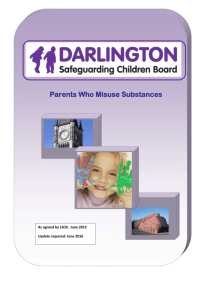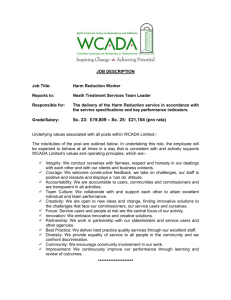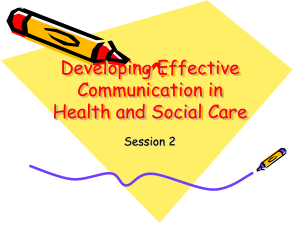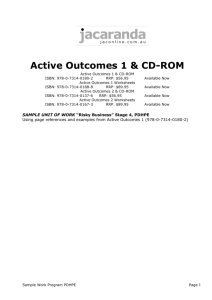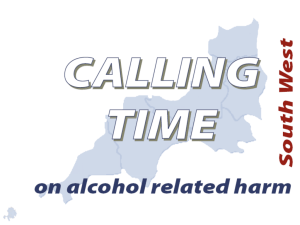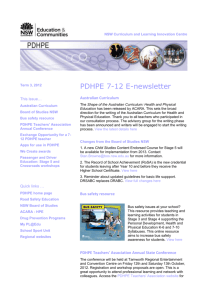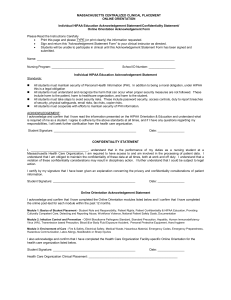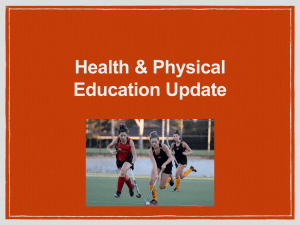Young People and Drugs:
advertisement
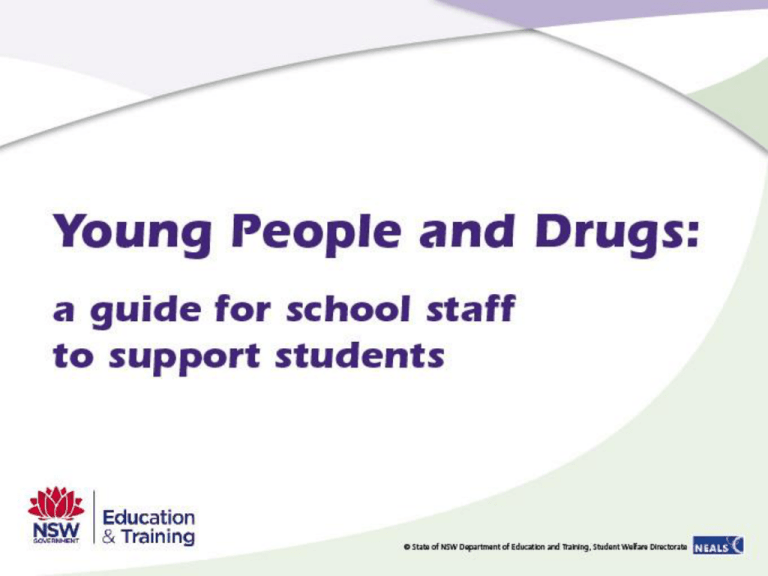
1 Purpose To assist schools to: • implement appropriate prevention strategies to support young people at risk of drug related harm • identify when a young person may have a drug use problem • plan and implement targeted intervention to support young people with drug use problems • link young people and families to services and resources • access drug and alcohol information services. 2 Young People and Drugs What is drug misuse? Drug misuse is any use of drugs that causes physical, psychological, economic, legal or social harm to the individual user or to others by the drug user’s behaviour. 3 Young People and Drugs Problems associated with adolescent drug misuse • Brain development in adolescence may be affected. • Delayed maturation during adolescence may impede important developmental tasks. • Drug use disorders are often associated with mental health disorders, suicide and a history of abuse. 4 Young People and Drugs Prevalence of drug use among NSW secondary students 12 to 17 years Substance Percentage reporting ever used Males Males Females Painkillers or analgesics 92.8 97.0 88.5 94.3 Alcohol 76.2 78.2 56.1 56.2 Tobacco 25.6 24.9 16.5 17.5 Inhalants 20.2 19.7 14.3 14.8 Cannabis 13.4 12.4 11.4 10.6 Sleeping tablets/ sedatives/ tranquillisers (non-medical use) 16.0 16.2 8.6 9.6 Ecstasy 4.9 3.9 4.5 3.3 Amphetamines (non-medical use) 3.6 3.7 3.2 2.9 NSW Secondary Schools Health Behaviours Survey: 2008 Report 5 Females Percentage reporting use in last 12 months Young People and Drugs IMPORTANT NOTE Most young people who try alcohol and illicit drugs do not become problem drug users. 6 Young People and Drugs Reasons young people use drugs • • • • • 7 To experiment To heighten sensations To relax To fit in with peers Because they are available Young People and Drugs • • • • To have fun To rebel To relieve boredom To cope with problems Indicators of possible drug use problems • Changes in appearance and wellbeing • Mood swings or significant personality change • Loss of initiative • Decline in academic performance • Increased need for money and secrecy • Intoxication at school 8 Young People and Drugs Identifying possible drug use problems: Cautionary notes • Behavioural change may be due to causes other than drug use. • Drug use is not necessarily drug misuse. • Drug use may increase as a result of getting into trouble for initial drug use and being labelled a ‘drug user’. 9 Young People and Drugs Confidentiality and privacy Issues of confidentiality and privacy can arise when teachers discuss possible drug use with students. 10 Young People and Drugs Limits of confidentiality • Teachers have a duty of care to protect young people against risks of harm. • Teachers should advise the principal of concerns about the welfare and safety of young people • Confidentiality may be limited by the requirements to advise the principal of concerns. • Students should be advised of the limits to confidentiality from the outset. 11 Young People and Drugs Talking to young people about possible drug use • Consider who is the best person to approach the student • Express concerns that can be supported by facts • Encourage the student to talk • Listen carefully and avoid moralising • Don’t use ‘scare tactics’ • Offer information or help 12 Young People and Drugs Strategies to support students • Offer support and information • Refer to the school counsellor for assessment, support or referral to outside agencies • Provide school based support as appropriate: - Learning support team - Support teachers - Home school liaison officer • Refer for brief intervention, if available 13 Young People and Drugs Useful contacts for schools • Drug education consultants • Student welfare consultants • NSW Health: - Area School-Link coordinators - Drug and Alcohol Services • Telephone help lines • Websites • Departmental resources 14 Young People and Drugs What is the role of the school in prevention? Providing a safe and supportive school environment where a student’s social, emotional and learning needs are met is most important in preventing drug use problems. 15 Young People and Drugs Drug prevention framework Quality learning and teaching Preventative drug education and proactive student wellbeing Effective approaches support for Parent involvement and support students at risk Safe, supportive and engaging environment 16 Young People and Drugs Community support Home, school and community partnerships Prevention involves interaction between the three focus areas Quality learning and teaching: – Provide curriculum that engages students and meets their needs – Teach drug education with K to 6, 7 to 10 and Crossroads 11 to 12 – Teach drug education in a planned, sequential and developmentally appropriate manner Safe, supportive learning environment: – Promote sense of belonging – Provide support at transition points – Build prosocial behaviours and problem solving skills – Promote pastoral care relationships 17 Young People and Drugs Home, school and community partnerships: – Consult parent and local community – Develop positive partnerships Prevention and early intervention 18 Young People and Drugs What is the role of the school in early intervention? • The earlier a young person begins using tobacco, alcohol or other drugs, the more likely it is that they will later develop a pattern of problematic use. • Intervening early to prevent a pattern of problematic drug use becoming established is important. 19 Young People and Drugs The Stages of Change model CONTEMPLATION ‘Hmmm …… Maybe this isn’t good for me’ DECISION PRECONTEMPLATION ‘What problem?’ ‘That’s it … I’m going to quit! ACT NOW ‘I’m doing something about it now’ RELAPSE ‘Oops … I used again’ MAINTENANCE ‘I’m still not using’ LONG TERM CHANGE ‘I haven’t used for ages’ 20 Young People and Drugs Source: Mentha, H. 2001 Referral to the school counsellor • The student has been suspended • Drug use is associated with high levels of risk • The student appears to be drug dependent • Drug use interferes with life at school and in the community • Drug use is associated with other problems – behavioural, family or mental health 21 Young People and Drugs Involving parents and caregivers • Be reassuring and don’t over dramatise • Help the parents explore options • Involve the student in decisions • Give information and/ or suggest referral • Allow the parents to express their concerns 22 Young People and Drugs Supporting students whose parents use drugs • Reframe perceptions of disloyalty • Encourage discussion • Advise young people to seek help from a trusted relative or family member • Promote a positive outlook • Report suspected abuse and neglect 23 Young People and Drugs Improving drug prevention and intervention • Learn about early intervention options • Identify school needs from the review • Consider how to address school needs • Determine staff training needs • Plan for targeted intervention 24 Young People and Drugs Early intervention strategy • Context for early intervention: whole school drug prevention and intervention. • Early intervention options: 1. Keep them talking – a staff resource 2. KEEP LEFT: Smoking cessation in schools 3. Alcohol – My Reality. 25 Young People and Drugs Review of current drug prevention and intervention practices Survey results: Strengths identified from the survey Areas for improvement identified 26 Young People and Drugs Helping students to be non-smokers • Ensure students and the school community are aware of rules and consequences • Treat smoking, firstly, as a health issue • Include tobacco education in PDHPE • Provide information about QUIT programs • Implement a brief intervention (KEEP LEFT) • Provide incentives to reduce and quit • Display anti-smoking stickers and posters • Use appropriate resources in PDHPE eg Smoke screen, The Critics’ Choice 27 Young People and Drugs Helping students to stay safe around alcohol • Treat adolescent drinking as a health issue • Include alcohol education in PDHPE • Provide information about alcohol guidelines for students, staff and parents • Promote behaviours that help students avoid alcohol related harm • Provide normative education about alcohol use • Provide information to parents to help them manage the drinking behaviour of their children 28 Young People and Drugs
